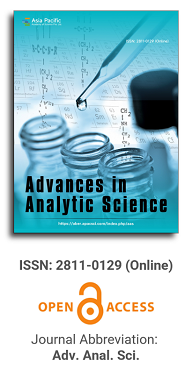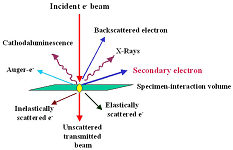
Asia Pacific Academy of Science Pte. Ltd. (APACSCI) specializes in international journal publishing. APACSCI adopts the open access publishing model and provides an important communication bridge for academic groups whose interest fields include engineering, technology, medicine, computer, mathematics, agriculture and forestry, and environment.

ICP-AES analysis of inorganic elements in Carthami Flos from various geographic locations
Vol 1, Issue 1, 2020
Download PDF
Abstract
Using microwave digestion and inductively coupled plasma atomic emission spectroscopy (ICP-AES), 28 inorganic elements were analyzed in 40 batches of safflower (Carthamus tinctorius Linn.) samples, which are the dried tubular flowers, from Anhui, Gansu, Jiangsu, Xinjiang, and Yunnan. The results revealed the following: Among the heavy metals, copper (Cu) had the highest concentration across all 40 batches of safflower samples, with mercury (Hg) and lead (Pb) also being relatively high. Safflower samples from Yunnan had significantly higher Hg levels compared to those from other provinces. The levels of Pb and Cu among samples from different provinces were generally not significantly different, while arsenic (As) and cadmium (Cd) levels were either low or undetectable. Among the major elements, potassium (K) had the highest concentration, phosphorus (P) and magnesium (Mg) were lower, and sodium (Na) had the lowest concentration. Safflower samples from Gansu had significantly higher Na and Mg concentrations, and samples from Yunnan and Xinjiang had higher P levels compared to those from other provinces. Safflower samples from Yunnan had significantly lower K levels compared to samples from other provinces, and there were no significant differences in K levels among samples from the other provinces. In the case of essential trace elements, iron (Fe) and boron (B) were relatively high, while nickel (Ni) was the lowest. Safflower samples from Xinjiang and Gansu had higher chromium (Cr) levels, and samples from Gansu had the highest levels of manganese (Mn), Fe, Ni, and strontium (Sr), while samples from Anhui had the highest levels of Zn and B. Conversely, samples from Jiangsu had the lowest levels of Cr, Mn, Fe, and Ni; Gansu samples had the lowest Zn levels; and Yunnan samples had the lowest Sr and B levels. Principal component analysis and cluster analysis showed that safflower samples from the same province tended to cluster together. Specifically, samples from Anhui and Jiangsu clustered closely, samples from Gansu and Xinjiang were relatively close, and samples from Yunnan were more distanced from those of other provinces. This study established a rapid and accurate method for determining the inorganic element content in safflower, and the results indicated notable differences in inorganic element content among safflower samples from different origins.
Keywords
References
- National Pharmacopoeia Committee. Pharmacopoeia of the people’s Republic of China: 2015 Edition (one). China Medical Science and Technology Press; 2015. p. 151.
- Ren C, Wu Y, Tang X, et al. Origin and origin change of safflower. Chinese Journal of traditional Chinese medicine. 2017; 42(11): 2219-2222.
- Yang J, Cui Y. Research on traditional safflower dyeing technology: planting and processing safflower. Take pigment extraction and dyeing printing as an example. Journal of Zhejiang textile and clothing vocational and technical college. 2013; 12(1): 88-91.
- Li B, Wang J, Azezi Guli J, et al. Correlation analysis of trace elements between Xinjiang safflower and its origin. Life science instruments. 2018; 16(6): 50-57.
- Xu D, Sun Q, Shen Z, et al. Content and correlation analysis of heavy metals in rhizosphere tailings and plants of Coreopsis Rapa in copper tailings pond. Journal of plant resources and environment. 2018; 27(1): 27-36.
- Guo Y, Shen D, Yang H. Analysis of the prescription rule of traditional Chinese medicine containing safflower. Chinese Journal of traditional Chinese medicine. 2014; 39(11): 2144-2148.
- Vafaie A, Ebadi A, Rastgou B, et al. The effects of potassium and magnesium on yield and some physiological traits of safflower (Carthamus tinctorius). International Journal of Agriculture and Crop Sciences. 2013; 5(17): 1895-1900.
- Houshmandfar A, Moraghebi F. Effect of mixed cadmium, copper, nickel and zinc on seed germination and seedling growth2o2f safflower. African Journal of Agricultural Research. 2011; 6(6): 1463-1468.
- Le S. Study on chemical constituents and activity evaluation of safflower. School of pharmacy, Nanjing University of traditional Chinese medicine; 2015.
- Kumar S, Ambreen H, Murali TV, et al. Assessment of genetic diversity and population structure in a global reference collection of 531 accessions of Carthamus tinctorius L.(safflower) using AFLP markers. Plant Molecular biologyreporter. 2015; 33(5): 1299-1313.
- Delshad E, Yousefi M, Sasannezhad P, et al. Medical uses of Carthamus tinctorius L.(safflower): a comprehensive review from traditional medicine to modern medicine. Electronic Physician. 2018; 10(4): 6672-6681.
- Lin H, Li G, Liu H, et al. Species and distribution of safflower germplasm resources in China. Biological resources. 2018; 40(4): 314-320.
- Guo H, Gao G, Wu Q, et al. Determination of five heavy metals residues in safflower injection by ICP-MS. Zhongnan pharmacy. 2011; 9(11): 833-835.
- Li D. Study on quality control method and determination of metal elements of Xuefu Zhuyu pills. School of pharmacy, Shenyang Pharmaceutical University; 2008. p. 7.
- Xu J. Full of snow jade Application of atomic absorption spectrometry in drug analysis. Comprehensive utilization of resources in China. 2018; 36(2): 84-86.
- Zhai Y, Chen J, Li X, et al. Determination of mineral elements in south wild jujube and its extract by ICP-AES. Spectroscopy and spectral analysis. 2015; 35(4): 1052-1055.
- Shu F, Zhang Y, Wang H, et al. Study on the memory effect of mercury determination by ICP-MS. Chinese Journal of sanitary inspection. 2016; 26(2): 189-191.
- Sayyad G, Afyuni M, Mousavi S, et al. Effects of cadmium, copper, lead, and zinc contamination on metal accumulation by safflower and wheat. Soil and sedimentcontamination: An International Journal. 2009; 18(2): 216-228.
- Tian D, Ding R, Wang L. Determination of trace elements in Ningxia safflower by microwave digestion atomic absorption spectrometry. Anhui Agricultural Science. 2012; 40(23): 11565-11567.
- Zhang H. Effects of lead stress on safflower growth and GSH expression. College of life sciences, Henan Normal University; 2013. p. 38.
- Jian Z, Meng L, Xu G, et al. Absorption and accumulation of mineral elements in soil by safflower. Guangxi plant. 2014; 34(4): 557-560.
- Jia H, Tan Y, Sun X, et al. Effect of Fertilization on safflower growth and yield. Journal of Xinjiang Agricultural University. 2010; 33(5): 394-397.
- Hu X, Yang W, Huang L, et al. Study on the absorption and distribution of nitrogen, phosphorus and potassium in safflower. Journal of Northwest University of agriculture and forestry science and Technology (Natural Science Edition). 2018; 46(7): 32-37.
- Hu X, Hu Z, Yang J, et al. Breeding of New Safflower varieties’ yunhonghua No. 5 ‘and’ yunhonghua No. 6 ‘for both flower and oil. Chinese agronomy bulletin. 2017; 33(17): 58-65.
Supporting Agencies
Copyright (c) 2020 Zongjin Pu, Guisheng Zhou, Hui Yan, Guoping Peng, Shulan Su, Shengliang Huang, Jin’ao Duan

This work is licensed under a Creative Commons Attribution 4.0 International License.

This site is licensed under a Creative Commons Attribution 4.0 International License (CC BY 4.0).
1.jpg)
Prof. Sivanesan Subramanian
Anna University, India





.jpg)
